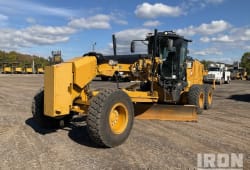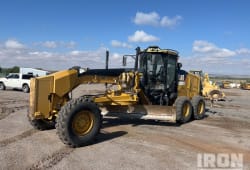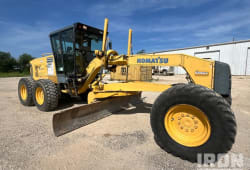A Complete Overview on Motor Graders
7 Min read
)
November 25, 2023
Motor graders are essential pieces of equipment in the construction and road maintenance industry. They play a crucial role in ensuring smooth and properly graded surfaces for various applications. In this comprehensive guide, we will delve into the world of motor graders, exploring what they are, how they work, the benefits they offer, and important considerations when choosing and using this equipment.
What Are Motor Graders?
Motor graders are heavy-duty machines designed for grading and levelling surfaces, particularly in the construction and maintenance of roads. These robust pieces of equipment consist of a long blade positioned between the front and rear axles, allowing for precise control over the grading process. The blade can be adjusted to different angles and depths, making motor graders versatile in shaping the terrain according to specific project requirements.
How Do Motor Graders Work?
Motor Grader's equipment operates through a combination of hydraulics and precision controls. The operator sits in a cab equipped with a comprehensive control panel, allowing them to manipulate the blade's position, angle, and depth. The grader moves forward, and as it progresses, the blade grades the surface by cutting, filling, and levelling the material. The articulated frame ensures flexibility, enabling the grader to navigate curves and uneven terrain with ease.
Benefits of Using Motor Graders
Precision Grading: Motor graders excel in providing accurate and precise grading, crucial for creating level surfaces necessary in road construction and maintenance.
Versatility: These machines are adaptable to various terrains, making them suitable for a wide range of projects, from building roads to preparing construction sites.
Time Efficiency: Motor graders significantly reduce the time required for grading tasks compared to manual methods, enhancing overall project efficiency.
Cost Savings: The efficiency and versatility of motor graders contribute to cost savings by reducing labour and operational expenses.
How to Choose the Right Motor Grader for Your Needs?
Selecting the right motor grader for a project involves considering several key factors:
Blade Size and Type: The blade size and type should match the project requirements. Larger blades are suitable for extensive grading, while smaller blades provide more precision.
Horsepower: The grader's horsepower determines its capability to handle different materials and work on varying terrains.
Control System: Opt for a motor grader with user-friendly controls, ensuring the operator can efficiently manage the machine's functions.
Attachments and Accessories: Some motor graders come with additional attachments and accessories, such as ripper teeth or scarifiers, enhancing their versatility.
Troubleshooting Common Motor Grader Problems
While motor graders are robust machines, they may encounter issues. Common problems include hydraulic leaks, uneven grading, and electrical issues. Regular maintenance and prompt troubleshooting are essential to keep the equipment in optimal working condition.
Safety Features and Regulations
Safety is paramount in the operation of motor graders. Modern motor graders come equipped with various safety features, including:
Rollover Protection System (ROPS): Protects the operator in the event of a rollover.
Visibility Enhancements: Features like cameras and mirrors improve the operator's visibility, reducing the risk of accidents.
Emergency Stop Systems: Enables the operator to quickly halt operations in case of an emergency.
You may read: Benefits of Motor Graders for Road Construction and Maintenance
Adherence to safety regulations, proper training, and routine equipment inspections are crucial for preventing accidents and ensuring a safe working environment.
Innovation in Motor Grader Technology
Continued advancements in technology are shaping the future of motor graders. Intelligent grading systems, GPS integration, and telematics are becoming standard features, further enhancing the precision and efficiency of these machines. GPS technology, for instance, allows operators to follow pre-programmed designs, ensuring a higher level of accuracy in grading and minimising material wastage.
Maintenance Tips for Longevity
To maximise the lifespan and performance of motor graders, regular maintenance is essential. This includes routine checks of hydraulic systems, engine components, and blade functionality. Keeping blades sharp and well-maintained ensures optimal cutting and grading performance. Additionally, following the manufacturer's recommended maintenance schedule and promptly addressing any identified issues can prevent major breakdowns and costly repairs.
Training and Certification for Operators
Proper training is critical for motor grader operators to ensure safe and efficient use of the equipment. Many accidents and operational inefficiencies can be attributed to inadequate training. Certification programs are available to educate operators on the technical aspects of motor graders, safety protocols, and troubleshooting procedures. Investing in operator training contributes to a skilled workforce, reduces accidents, and enhances overall project productivity.
The Role of Motor Graders in Disaster Response
Motor graders are not only vital in routine construction and maintenance tasks but also play a crucial role in disaster response. In the aftermath of natural disasters such as hurricanes, earthquakes, or floods, motor graders are deployed to clear debris, repair damaged roads, and restore access to emergency vehicles. Their versatility and ability to work in challenging conditions make them indispensable in disaster recovery efforts.
The Collaborative Future: Motor Graders in Smart Construction
As the construction industry embraces the era of smart technologies, motor graders are becoming integral components of interconnected construction ecosystems. These smart construction sites leverage data analytics, IoT (Internet of Things) sensors, and real-time communication to enhance project management and decision-making processes. Motor graders equipped with telematics can provide valuable data on fuel consumption, operational efficiency, and maintenance needs, contributing to more informed and proactive construction site management.
Addressing Environmental Concerns: Green Technologies in Motor Graders
With growing environmental awareness, the motor grader industry is actively exploring green technologies to reduce its ecological footprint. Manufacturers are developing hybrid and electric motor graders to decrease dependence on traditional fossil fuels. These innovations not only align with global sustainability goals but also offer long-term cost savings through reduced fuel consumption and lower emissions.
The Impact of Motor Graders on Rural Development
In rural areas, motor graders are instrumental in transforming landscapes and improving accessibility. Gravel roads, common in rural regions, benefit significantly from motor grader maintenance and grading. Properly maintained roads enhance connectivity, allowing for easier transportation of goods and services. This, in turn, stimulates economic development in rural communities, showcasing the far-reaching impact of motor graders beyond urban construction projects.
Challenges in Emerging Markets: Accessibility and Affordability
While motor graders are ubiquitous in developed countries, emerging markets face challenges related to accessibility and affordability. Limited infrastructure, lack of trained operators, and financial constraints hinder the widespread adoption of motor graders in some regions. Industry stakeholders, including governments and international organisations, play a vital role in addressing these challenges through targeted investments, training programs, and financial support to make motor graders more accessible to a broader global audience.
Global Collaboration for Sustainable Infrastructure
As the demand for infrastructure development continues to rise globally, there is a growing need for collaborative efforts to ensure sustainability. International collaborations, knowledge sharing, and technology transfer can contribute to creating resilient and environmentally friendly infrastructure. Motor graders, as essential tools in this development, become catalysts for positive change when integrated into a holistic, globally coordinated approach to infrastructure construction and maintenance.
The End
Motor graders are indispensable in the construction and maintenance of surfaces worldwide. From precision grading to disaster response, these machines continue to shape the landscape of infrastructure development. As technology advances, motor graders are becoming smarter, more efficient, and environmentally friendly. The key to maximising their potential lies in proper training, regular maintenance, and staying abreast of industry trends. As we look towards the future, the role of motor graders in building a more connected, accessible, and sustainable world remains pivotal.















